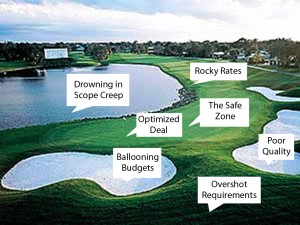- July 13, 2011
- UpperEdge
- Reading Time: 4 minutes
 A few weeks ago, I told you about the many ways that golf and IT sourcing are similar. And the more I think about it – which I usually do on the golf course – the more similarities I see.
A few weeks ago, I told you about the many ways that golf and IT sourcing are similar. And the more I think about it – which I usually do on the golf course – the more similarities I see.
Take for example the idea of course management. Basically it boils down to knowing where the risks and opportunities are on every shot, when to go right at the pin with a high-risk/high-reward approach shot or when to lay up short. In IT sourcing, too, there is usually a time to be aggressive and push vendors for extra discounts or higher performance guarantees, and a time to play it safer, to trade immediate-term financial gain for long-term value creation.
And don’t forget to look at how one approach or shot can impact the next shots. For example, in IT sourcing, focusing on lowering resource rates can impact the quality of the resources you receive; or a fixed-fee deal may feel like a nice security blanket, but can quickly grow as a result of scope creep if you’re not careful. The point is, you need to take into account many factors before deciding on a specific approach, including what the next shot may entail if you are unable to execute to your original plan. Like Mike Tyson once said, “Everybody has a plan until they get punched in the mouth.” In golf and IT sourcing, it’s more like, “Everybody has a plan until they get into trouble.”
This little diagram will help you see the Consigliere’s point:

Optimized deal: That flag sure looks inviting, but look at the risks all around – bunkers left, water right, and deep rough behind. It may be better to play the safer choice and aim for the middle of the green. In other words, going for the last dollar of discount may put you in a very tough spot. And uphill putts are almost always easier to read and execute more confidently.
Rocky rates: Early discussions sound like everyone knows where “par pricing” needs to be, but as you move up closer to the green, the rates aren’t lying very pretty at all. In fact, they keep getting rockier, making it nearly impossible for you to play a good shot to your ultimate goal.
Poor quality: Sure, everyone wants low-cost providers, but it may be impossible to get out of the low-quality trap once you’re in it. It’s no beach in there, the Consigliere can tell you!
Overshot requirements: It’s easier than you think to go long and happens for several reasons – straight mis-hits, taking too much club (especially to a negotiation) or blading a relatively easy wedge shot. Don’t overestimate your requirements. Instead know your limits, stay focused on your goals and choose your approach accordingly – no gripping and ripping, please, and no buying more than you need!
Ballooning budgets: This is often the easiest trap to hit, though the problems often start with poorly defined requirements or ambiguous contract terms (i.e., proper identification of yardage, the lie of your ball, and the impact of weather conditions). Know exactly where this bunker is and the various factors that, if misread, can land you in it. That’s how to stay out of the bunker!
Drowning in scope creep: That lake is so big and obvious that no one could ever possibly hit it there, right? Wrong. Everybody hits it there. Just like scope creep. And it even happens on so many deals and to IT executives who should know better. All it requires is a little extra attention to detail to remove any ambiguities and ensure the contractual language accurately reflects mutually agreed expectations. There is no reason to hit it there – so don’t!
The safe zone (aka, the fat part of the green): Oh, sure, it seems like the place to aim once you consider all the other risks around, but golfers often overlook it because they do not want too long of a birdie putt and the potential risk of a three-putt bogey. But the safe zone provides plenty of margin for error in your ability to execute the “safe” shot that will still leave you on the green and take potential major disaster (double bogey, triple bogey, or worse!) out of the equation. Remember, if you play to your tendencies, you will only take risks where you are extremely confident at executing or certain that you can get out of potential trouble should you fail to execute. So if you have doubts about hitting the target for the optimized deal or navigating the other hazards should you mis-hit it, the fat part of the green is still your best option.
Well, the CIO Consilgliere could talk about golf and IT sourcing all day long, but fortunately today I have an early tee time so … ciao for now!